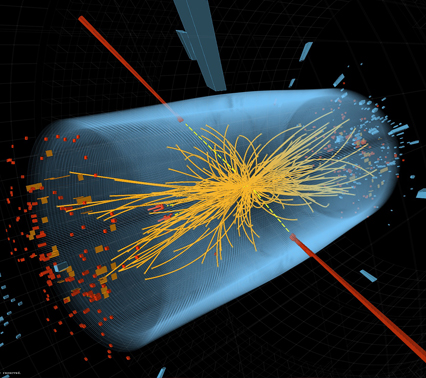【翻译】庆祝希格斯玻色子的最终发现!
By 苏剑林 | 2012-07-18 | 25626位读者 |笔者:对于科学界来说,七月份最重大的事情莫过于在LHC我们终于发现了希格斯玻色子的踪迹。BoJone到《新科学家》网站上选取了一篇文章进行翻译,让大家了解其中的一些事情。当然,发现这个希格斯玻色子已经是七月四号的事情了,现在已经是非常迟到了,中间的原因就是宇宙驿站的故障了......迟到总比没到好,现在发出来,与大家共勉。翻译得不好,请指出毛病,高手见笑了^_^
庆祝希格斯玻色子的最终发现!
作者:日内瓦的CERN 的Celeste Biever 2012年7月4日
虽然还有千万分之五的出错可能,但这足以让物理学家们宣告希格斯玻色子(Higgs Boson)——世界最渴望的粒子——已经被发现了。在瑞士的日内瓦附近,欢天喜地的掌声和喝彩声遍布了欧洲核子中心(CERN)礼堂的每一个角落。
距离科学家首次预测希格斯玻色子的存在将近50年了,这一次突破这意味着“粒子物理标准模型”,一个能够解释所有已知粒子以及作用在其上的力的物理模型,已经完整了。
改实验的头儿今天在CERN宣布:希格斯玻色子的质量在125到126GeV之间,它分别被大型强子对撞机(LHC)的两个孪生探测器——CMS和ATLAS观察到,每个探测器的误差都是5 sigma。(sigma表示相对误差,表示千万分之五,相对于125GeV,它就是5eV)。就算以粒子物理学家的严格标准来衡量,它还是有足够重要的意义,使它能够被视为一种粒子的发现。
“我想我们已经找到了它。”CERN的总干事Rolf Heuer说。他在当地时间上午九点举行的一个备受关注的研讨会中得出这样的结论。在澳大利亚的墨尔本举行的国际高能物理大会(ICHEP,即International Conference on High Energy Physics)向世界公示了这些结果。
成队的鸭子
Pier Oddone,伊利诺伊州芝加哥市的费米实验室(现已关闭的万亿电子伏特加速器(Tevatron)就坐落于这里)的主任,从另一个角度表达了他对这项发现的看法。“如果它看起来像是一只鸭子,也像鸭子般走路,那么它将会是一只鸭子。”他说。
CMS的Joe Incandela 和ATLAS的Fabiola Gianotti报告支持,他们发现了多出的粒子,正好满足希格斯玻色子的质量在125到126GeV间这一特点,他们自信误差只有5 sigma——他们的引起了在场人员的起立欢呼!该结果大体上满足这两个队伍在12月报告的结果,那时他们发现了希格斯玻色子的“踪迹”,但缺乏足够多数据,没有统计学意义。
昨天晚上,大概是23时,人们开始排队进入礼堂,甚至在外边扎起了帐篷。很多从今天早上开始排队的人被拒之门外,因为实在没有空间了。过去几天,关于这件事的传言、泄漏和炒作等闹得沸沸扬扬——而事实是这项发现原则上只是收集到了一批数据——虽然对这些备受关注的“产物”中我们拥有了最可喜的自信,但目前鼓舞人心的希格斯玻色子探测结果还不是一个完整的惊喜。
最基本的
希格斯玻色子给予了所有基本粒子质量,允许了物质的存在。它是希格斯场(一个所有粒子都必须经过的实体场)的基本单元,或者说量子。有些粒子,如光子,能够轻而易举地摆脱它——因为它们没有质量;然而,另外的粒子却必须努力挣脱它,它们就像黏在了糖浆上了的蝴蝶一样。标准模型中需要希格斯玻色子以及它组成的场,但在今天的报告之前,它们从未被肯定地探测到过。
研讨会中充满了兴奋的情绪。在1964年首先预测了希格斯玻色子的Peter Higgs,称之为“我一生中最难以置信的事情”。
但物理学家们不大希望将它称为“希格斯玻色子”的发现,而更愿意叫做“新玻色子”的发现。因为目前他们还无法了解它的特征——同样还不能证实它同标准模型的希格斯玻色子究竟有多相似。“现在是这种玻色子特征的漫长探索之旅的开始。”Heuer指出。一个必须了解的特征是这种玻色子的自旋:标准模型认为它的值必须为0;而一些更奇特的玻色子的自旋值为2。CMS的Oliver Buchmueller 说今年年底LHC应该就可以测定这种新玻色子的自旋。
我们知道标准模型仍然是不完整的——打从一开始它就没有囊括暗物质和引力——所以一个非标准模型的希格斯玻色子会让人非常兴奋。
“每个人不仅仅因为这项发现本身而高兴,更因为这项发现为这个领域所带来的前景而兴奋。”Heuer如是说。
英文原文
http://www.newscientist.com/article/dn22014-celebrations-as-higgs-boson-is-finally-discovered.html
Celebrations as Higgs boson is finally discovered
11:52 04 July 2012 by Celeste Biever, CERN, Geneva
There's a 5-in-10 million chance that this is a fluke. That was enough for physicists to declare that the Higgs boson – the world's most-wanted particle – has been discovered. Rapturous applause, whistles and cheers filled the auditorium at CERN, near Geneva, Switzerland.
Almost 50 years after its existence was first predicted, the breakthrough means that the standard model of particle physics, which explains all known particles and the forces that act upon them, is now complete.
A Higgs boson with a mass of around 125 to 126 gigaelectronvolts (GeV) was seen separately by the twin CMS and ATLAS detectors at the Large Hadron Collider, each with a confidence level of 5 sigma, or standard deviations, the heads of the experiments announced today at CERN.
Even by particle physicists' strict standards, that's statistically significant enough to count as a particle discovery.
"I think we have it," said Rolf Heuer, director general of CERN, as he concluded a hotly-anticipated seminar, which began today at 9am local time.
Around the world the results were being watched at the International Conference on High Energy Physics in Melbourne, Australia.
Ducks in a line
Pier Oddone, director of Fermilab near Chicago, Illinois, home of the now-defunct Tevatron collider, expressed his views on the discovery in a different way. "If it looks like a duck and it walks like a duck it's going to be a duck," he said.
Joe Incandela of CMS and Fabiola Gianotti of ATLAS reported seeing excesses of particles that fit the profile of a Higgs with a mass of 125 and 126 GeV respectively. Both claimed 5 sigma confidence in the result – and both announcements were met by standing ovations.
That result broadly agrees with earlier, less statistically significant "hints" of the Higgs reported by the same two teams in December.
People started queuing to get into the auditorium at about 11pm last night, camping out. Many of those who started queuing this morning were turned away because there wasn't room.
Given a flurry of rumours, leaks and hype over the past few days – and the fact that a discovery was in principle possible given the volume of data collected – the positive Higgs result is not a complete surprise, though the confidence we can have in the result is the best of the anticipated outcomes.
It's elementary
The Higgs boson gives all elementary particles mass, allowing for the existence of matter. It is the fundamental unit, or quantum, of the Higgs field, an all pervading entity that all particles must pass through.
Some, like the photon, slip through unhindered – they are massless. Others, though, must struggle like a fly trapped in treacle. The Higgs and its field are required by the standard model, but had never been conclusively detected before today's report.
The seminar was full of emotion and elation. An emotional Peter Higgs, who postulated the boson that is his namesake in 1964, called it "an incredible thing that happened in my lifetime".
The physicists were a little reticent to call the discovery a "Higgs boson", preferring to call it the discovery of a "new boson".
That's because they don't yet know its properties – and so can't confirm how similar it is to the Higgs of the standard model. "It's the beginning of a long journey to investigate all the properties of this particle," says Heuer.
One property that needs to be investigated is the particle's spin: the standard model says it should have a value of zero; a more exotic boson would give a value of two. Oliver Buchmueller of CMS says the LHC should be able to determine the new boson's spin by the end of 2012.
We know that the standard model is not complete – it does not contain dark matter or gravity, for a start – so a non-standard model Higgs could be very exciting.
"Everyone is not just excited about the discovery, but about the prospects this discovery offers to the field," says Heuer.
转载到请包括本文地址:https://www.spaces.ac.cn/archives/1661
更详细的转载事宜请参考:《科学空间FAQ》
如果您还有什么疑惑或建议,欢迎在下方评论区继续讨论。
如果您觉得本文还不错,欢迎分享/打赏本文。打赏并非要从中获得收益,而是希望知道科学空间获得了多少读者的真心关注。当然,如果你无视它,也不会影响你的阅读。再次表示欢迎和感谢!
如果您需要引用本文,请参考:
苏剑林. (Jul. 18, 2012). 《【翻译】庆祝希格斯玻色子的最终发现! 》[Blog post]. Retrieved from https://www.spaces.ac.cn/archives/1661
@online{kexuefm-1661,
title={【翻译】庆祝希格斯玻色子的最终发现!},
author={苏剑林},
year={2012},
month={Jul},
url={\url{https://www.spaces.ac.cn/archives/1661}},
}











October 7th, 2012
已经发现啦!前几天恰巧看到了有关的纪录片,没发现时的,这才意识到这东西的价值啊。
March 3rd, 2014
“sigma是一个量的名称,单位是eV,5 sigma意味着5eV”的说法是不准确的。Sigma是统计学里的标准差,用来衡量实验的误差。单位由描述的量决定,没有确定的单位。
我懂了,谢谢你~已经修改好了,你再看看?